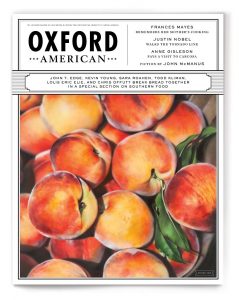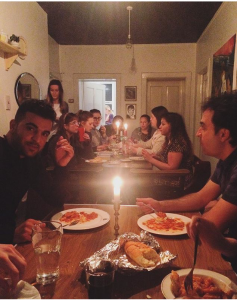The Reason I Chose This Project
When I started the doctor of ministry program here at Candler, I was serving as Pastor of a Baptist church in Hyattsville, Maryland, just outside of Washington, D.C. It is one of the most diverse churches I know of anywhere. Ethnically, generationally, theologically, politically, economically, educationally – it had all the colors of the human rainbow. On any given Sunday, the congregation in the pews was roughly 60% white and 40% black. That view from the pulpit is what I’d always hoped I’d see in post “I Have a Dream” America. Diversity was the congregation’s greatest asset – and its biggest challenge. In such a diverse environment, power was growing more insular, not less, as I had expected. The sanctuary might have been 60/40, but the boardroom was 90/10 on its most egalitarian day. As a privileged white man, my eyes were opening to the great difference between desegregation and integration.
Then, in early 2015, the March edition of Oxford American Magazine (a Christmas gift from my brother) arrived in my mailbox, and my eyes were opened even wider. One of the peculiar features of church life in Hyattsville was how infrequently this congregation ate together. There was even active opposition to community meals from certain quarters within the old guard. (It’s too much trouble. It makes meetings so much longer). This issue of Oxford American was devoted to food, and I was pleasantly surprised to discover an article written by Washington Post food critic Todd Kliman in the heart of the feature section: “Coding and Decoding Dinner.” In it, Kliman wrestles with his growing realization that he sees very few African-Americans in the dining rooms of Washington D.C.’s burgeoning restaurant scene. It shouldn’t be so, he reasons, given metro D.C.’s broad ethnic diversity and the presence of a well-established, affluent black middle class. But it was so. In asking, “why?” restaurateurs introduced Kliman to something he dubs “The 60/40 Line.” [1] According to these restaurant insiders, whenever the dining room becomes more than 40% black, the white customers start to leave, never to return. 60/40 is the tipping point where whites become exceedingly uncomfortable in a shared space.
Washington’s lone diverse dining room, Kliman revealed, is Busboys and Poets, which had just opened its seventh location in Hyattsville’s new Arts District. Kliman’s article concludes with a conversation with Busboys’ founder, Andy Shallal, an Iraqi immigrant who came to America as a child in the racially charged 1960s. Shallal explains that restaurants are “coded.” The décor, the menu, the music – all of it says, “Welcome,” to certain people and, “Keep Out,” to others. If you want to foster diversity, you have to “code” for multiple audiences and negotiate that “60/40 Line.”
Todd Kliman exposed the source of the growing tension within my congregation (the “60/40 Line”), and he and Andy Shallal prompted me to began thinking about the connections between food and community. Was the lack of eating together a symptom of the tensions at church, or was it a driving factor? Or both? If I could get the congregation to sit down around the dinner table regularly, might that change the relationship dynamics? Might that possibility be the very reason certain people did not want to sit down and eat?
Yet, there was one meal we shared on a regular basis – the meal all Christians share in one way or another: the Lord’s Supper. We shared the bread and ate it together. We shared the cup and drank it together. How might that sacred meal inform how we should be eating other meals? Christ says, “Do this in remembrance of Me.” What is “this,” precisely? And might a fuller understanding of what “this” means reveal a way forward across the divisions plaguing the congregation, and more widely our nation? These are the questions I set out to answer through my final project.
Project Explanation

Detail of a symposium fresco in the “Tomb of the Diver” in Paestum, Italy, ca. 470 BCE. Source: Brown University
My project unfolded in four stages. First, I explored the history of meals in the Greco-Roman world Jesus knew. I wanted to see what similarities there were between that culture and our own. Food is a curious contradiction. On the one hand, it serves as a powerful catalyst for the creation of lasting friendships. On the other, it contributes significantly to the web of demarcation lines that form social boundaries, including ethnicity, class, gender, and geography. In Jesus’ day, as in our day, what a person eats, where they eat it, and with whom they eat it contributed significantly to their socio-political identity.
Second, I explored Jesus’ eating habits as recorded in the Gospels against the cultural backdrop of Greco-Roman dining. Jesus is frequently portrayed at table, both with “sinners” of various stripes and high-ranking members of the religious establishment. Imitating Christ is a central aspect of Christian discipleship. In both His table practice and the parables He told about food, how did He negotiate (i.e. flout, endorse, or subvert) food as a social boundary?
Third, I examined the Last Supper, which is the model on which celebrations of the Eucharist are based, in light of Jesus’ table practice. What similarities and connections exist between the way Jesus shared tables during His life and this Table that He calls us to share in His memory? Should the Eucharist inform everyday eating habits for Christians, and if so, in what ways?
Finally, I identified the ways food continues to serve as a social boundary in 21st century North America, and sought out examples of contemporary organizations who are challenging that boundary through shared meals. I specifically looked for models both connected to and unaffiliated with the church (1) to avoid the assumption that all faithful food practice must be occurring inside the church and (2) to ensure valuable insights would not be missed by too “churchy” a focus. I researched the history of these organizations and interviewed leaders within six of the seven. [2]
Busboys and Poets (Washington, D.C.)
Busboys and Poets has become a Washington D.C. institution since the first restaurant opened on U Street in 2005. The name is a reference to Langston Hughes, who worked as a busboy at Washington’s Wardman Park Hotel for a time in the 1920s before he became a world-renowned poet of the Harlem Renaissance. It is a bookstore, a coffee shop, and a performance space (the best of what U Street was for the black community during the days of segregation) in addition to being a first rate restaurant, and one of the very few (if not the only) truly diverse dining rooms in the metro Washington D.C. area. Maintaining that diversity requires intentionality and a lot of dedicated, hard work.

(Left): The dining room at Busboys and Poets in Hyattsville, Maryland. (Right) A Nelson Mandela banner hanging over the bookstore section of the same establishment. Source: Dining Out in Baltimore, December 9, 2013.
The space must be “coded” to appeal to more than once audience, but according to Andy Shallal, if diversity is the goal, then non-Whites have to be considered first and foremost. “The Whites will come, because it’s a White world. If there is something new going on, something that has a buzz about it, they will come and check it out. The Blacks, the Latinos, they’re the ones you have to speak to in order to convince them that this is for them.” [3]
541 Eatery and Exchange (Hamilton, ON, Canada)
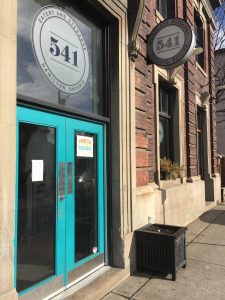
The distinctive blue doorway of the 541 Eatery and Exchange. Source: Jeni Riddell, She’s Frank (blog), December 2, 2016.
541 is a three-year-old cafe situated in an economically depressed area of Hamilton. The primary objective of the team behind 541 is to bridge the city’s economic divides, with the aim of welcoming the poor and treating them with dignity. Dignity involves offering them assistance without segregating them from the rest of society, and not serving them food that the affluent would shun.
The café operates as a non-profit staffed mostly by volunteers (80%). All of the food is made from scratch on the premises, using healthy, high quality ingredients, but is sold inexpensively. The most expensive item on the menu board the day I visited was the “full breakfast”: two eggs, potatoes, toast, and your choice of bacon or sausage for $6. Most main dishes run $4 – $5. Still, in this part of town, there are many who cannot afford even these prices. So, 541 has engineered a way for customers to help each other. Next to the register is a large jar full of buttons salvaged from thrift stores. Each button costs $1. When you pay for your meal, you can purchase as many buttons as you like, and drop the buttons you paid for into another jar, which customers who need a little extra can use like currency to help pay for their food. Each button is worth what it costs: $1. Any customer can use up to 6 buttons per day to place their orders, which means that anyone can receive one full free meal every day, even if they have no money of their own. They can even order the “full breakfast.”
“We chose this location deliberately,” 541’s Executive Director, Sue Carr, explains. “All of the [health and opportunity] indices were negative, and among the worst of the neighbourhoods around here. Unemployment is high, and it’s a bit of a food desert as well. There are basically only bars up and down this road, and no grocery stores to speak of. So we wanted to not only provide people with a source of food, but we wanted that food to be healthy and nutritious – not processed. Like homemade food.”
541’s food is helping to transform other aspects of health as well. “The food we serve is making a difference in peoples lives, but it’s also helping to create and strengthen community bonds.” One of the ways 541 intentionally nurtures those bonds is through a large harvest table in the center of the dining room. It can seat 12 comfortably. “[P]eople use it. Sometimes it’s a matter of necessity, because it can get very crowded in here, especially at lunch. So sometimes you wind up sitting with people you don’t know, but people make room and start up conversations. It seems to happen rather naturally.” [4]
St. Lydia’s (Brooklyn, NY)
Like 541, St. Lydia’s also helps foster a deep sense of community, but does so through worship conducted over a full meal that the congregants help to prepare, serve, and clean up as well as enjoy.
The community thus shaped around the table is life giving, but it can also be awkward. Visitors are frequent. There are some regulars who are homeless. Sharing the table with people you do not know, talking about life and faith, can be uncomfortable – and there is no “back pew” to withdraw to in St. Lydia’s model. In this way, St. Lydia’s creates “experimental” space: the kind of space in which relational patterns and social structures could be tested in a setting removed from the wider world. The tension created by such testing in such a space can, over time, become a catalyst for social change in the wider world. That is certainly what St. Lydia’s aims to accomplish.
Broadway United Methodist Church (Indianapolis, IN)
Broadway UMC is a traditional church that is transforming its urban community through very nontraditional ministry. Their philosophy is rooted in asset based urban development, and seeks to create partnerships and relationships with neighbors rather than offer handouts. Food is not front-and-center at Broadway in the same way it is at St. Lydia’s, but Rev. Mike Mather says shared meals are vital to what the church does and is able to accomplish.
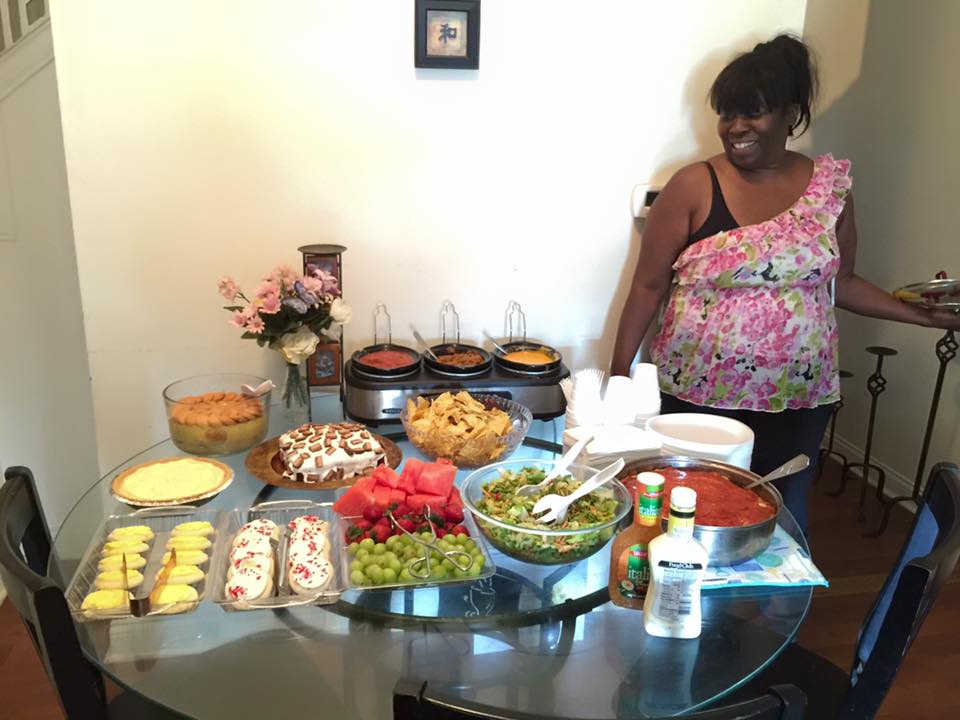
Ms. Sarah prepares food for youth “community listeners” at Broadway UMC. Source: Broadway United Methodist Church Facebook page.
“The presence of food causes people to behave in ways that are different than when it’s not present. Your body is literally more engaged in what’s taking place when you’re eating. You’re sharing goodies with others, and they’re sharing goodies with you. Meals become the settings for people seeing other people as they are.”
“That’s one reason we hardly have meetings anymore. Instead of meetings, we have meals. When you have a meeting, everyone attending has to add something extra to their schedule. But everyone has to eat, so when you’re sharing a meal you’re doing something everyone around the table would be doing anyway. But more than anything, meals create the kind of intimacy you can build relationships on. Food changes the nature of the conversation. You can be talking about the same topic, the same problem, but that conversation will sound different around the dinner table than it will around a boardroom table. A full meal is an unconscious sign of abundance. So, when you’re meeting over food – a meal, not just a snack – you’re starting with a reference point of plenty, not scarcity. That can influence what you think is possible. It’s more difficult to be all doom and gloom when there’s a table full of food right in front of you rather than a pile of papers.” [5]
Ryan Cook’s Intentional Community (Liverpool, United Kingdom)
Ryan Cook served on staff at a large, evangelical church in Alberta for ten years. In that role, he planned and organized many popular and creative programs. It was fun and rewarding work. Then one day it dawned on him that, despite his evangelical identity, he was living exclusively within the church. He did not have any significant relationships outside his faith. When Ryan and his family relocated to Liverpool, England, they decided to share a house with four other friends and form an informal intentional community devoted to prayer and the practice of hospitality, both as a faith discipline and as a way of finding a path back to the world. They committed to eating together on Monday evenings at 6:30, and to invite members of the community to join them. After two years, some Mondays saw 40-50 people show up for dinner, including neighbors, coworkers, strangers from the local coffee shop, the homeless: anyone they might have bumped into and invited over.
“I don’t think we would have had this same response or seen the relationships develop that we have seen if we were inviting folks to a book club or something like that. Food is universal. It’s a universal need, a universal pleasure. Everyone is connected to food. Food also gives you something to do with your hands and with your mouth when you don’t know what to do. Because let’s be honest, when you meet new people there are these awkward moments that are unavoidable. So the food can be a distraction, if you need it to be. It can also become part of the conversation, if you need it to be. It certainly becomes part of the shared experience that helps bring people together really like nothing else can.” [6]
Food Not Bombs (Kitchener, ON, Canada and Worldwide)
Food Not Bombs gives away free, homemade vegan/vegetarian food prepared from reclaimed ingredients as an act of protest against consumer capitalism and the growing militarization of the American economy. Their basic philosophy is that people should come before weapons and profit. It is a movement rather than an organization. There is no central headquarters or leadership. Anyone can start a chapter wherever they live and use the name, as long as they adhere to the philosophy’s core tenets.
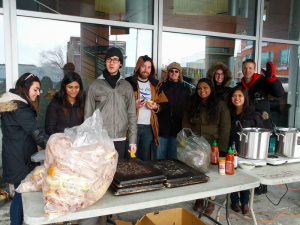
Dominic Aquilia (fourth from left) and volunteers from the Kitchener chapter of Food Not Bombs prepare to give away food in front of city hall. Source: Kitchener Food Not Bombs Facebook page.
I visited the FNB chapter in Kitchener, ON, which has been in operation for twenty years. Staffed mostly by student volunteers from the local university, they prepare three vegetarian soups each week in a borrowed commercial kitchen from food donated by local grocers and a bakery. The food is then given away in front of the Kitchener city hall on Saturday afternoon. Anyone can receive a free bowl of soup – no questions asked. Any leftovers are given to a men’s hostel that serves the homeless. Like St. Lydia’s, this FNB chapter has discovered the community building power of cooking together. Dominic Aquilia, the group’s principle organizer, explains: ” There’s something about sharing the same space with somebody – and not just sharing the space, but sharing it with a purpose – that creates a bond. We have to work together to get things done, and you talk while you work. I’ve made a lot of friends through Food Not Bombs, people I probably would not have met otherwise. I believe in the work, but that’s one reason I stay involved.” [7]
Mixed in the Six (Toronto, ON, Canada)
MI6 is the brainchild of Haan Palcu-Chang, an award-winning chef, and Gina Oades, an occupational therapist. Both of them are of mixed ethnic heritage, Chinese -Romanian and Filipino-Canadian respectively. MI6 is a “pop-up” dining event designed to help mixed race Torontonians find each other and build relationships over food, because many mixed-race individuals struggle to find a community. They belong to two different ethnic groups without having both feet planted in either one. For Palcu-Chang, the food is really the foundation of the event. Everything else stops at MI6 when it’s time to eat:

Chef Haan Palcu-Chang mingles with guests at a Mixed in the Six event. Source: Erin Kobayashi, Toronto Star News Service.
“I serve food that has a story, that is a fusion of different traditions – to mirror the life experience of those who attend. When you’re bringing people together who don’t necessarily know each other, the food is crucial. They can talk about the food if they struggle to start conversations around other things – so you want it to be really good. Food creates intimacy in so many ways. Food is something we all need. It’s multi-sensory; it engages all five senses, actually. It can recall memories from the past; give you a sense of home. So it really brings everyone’s humanity to the fore. I don’t think Mixed in the Six would work without the food. If we all showed up to just drink and listen to music, we wouldn’t be drawn together in the same way – even if we were in the same space.” [8]
Major Findings and Implications
Through His table practice, Jesus modeled the ministry of reconciliation that the Apostle Paul calls Christians to in 2 Corinthians 5:17-20. Specifically, Jesus challenged and undermined both the social basis (classism) and the theological basis (purity laws) of segregated eating by eating with both “sinners” and Pharisees, challenging the views of His hosts and fellow guests, and healing people while at dinner. Through food, He defied the “us” versus “them” mentality of His culture. [9]
These seven organizations have proven, in various ways and to varying degrees, that what Jesus modeled and accomplished through His own table practice is possible for us to accomplish through ours. Shared tables can bridge the divides that scar our world and disrupt our humanity. Shared tables can re-frame the ways we see and are seen. Shared tables can set in motion the changing of the world – if we are willing to open our tables and our selves to others. Some important take-aways for how to do that effectively are:
- Pay attention to how meals, and the environments in which they are served, are “coded.” Andy Shallal has demonstrated that the type of food you serve and how it is presented compose an unspoken message of welcome or unwelcome to various people. Authentic welcome is a key ingredient in hospitality. Think about the kinds of relationships that you want to help nurture, and then design a space that helps nurture those kinds of relationships. Avoid creating divisions between the servers and the served, and otherwise reinforcing social boundaries in your attempt to bridge them.
- Reconciliation cannot occur apart from dignity and respect being showed to “the other.” Empathy is not reconciliation, and neither is charity. Shared meals enable dignified and respectful relationships to develop because, as Ryan Cook observes, the table is a level surface. We face each other, we to one another, and we eat the same food.
- In extending genuine hospitality, we must be willing to go to “the other” and make ourselves uncomfortable. 541 Eatery and Exchange, for example, would not work if the leadership team had set up shop in the affluent side of town and expected the economically disenfranchised to come to them. They don’t live in that part of town, and they don’t feel comfortable (i.e. welcome) in that part of town.
- Whenever possible, cook together as well as eat together. Working as a team to prepare a meal provides another opportunity for people to talk and cooperation helps nurture bonds. Cooking together also blurs the lines between who is the host and who is the guest, and helps make the table an even more egalitarian space when the meal is served.
- Unstructured and un-coerced conversation around the table is key to building authentic relationships. Getting to know one another should be the only item on the agenda. The discussion should flow where it will, not unlike the Spirit, because relationships are cultivated in the wake of the conversations we have, not the other way around.
- Finally, the food matters. It cannot be an afterthought. It needs to look good. It needs to smell good. Above all, it needs to taste good. And it needs to be plentiful. Haan Palcu-Chang perhaps phrases it best: “The quality of the food you serve reflects your investment in the relationship you’re trying to cultivate. If you invest in the food – put your heart and soul, and time and effort into it, that’s going to send a message. If you serve whatever is most convenient and least expensive for you, that’s going to send a message, too.” [10]
What’s Next?
The next step for me is to begin “practicing what I preach” and start sending invitations to people who are on the other side of various social fissures from me. This project won’t amount to much if I’m not willing to turn my own table into a bridge. I also want to wrestle with some larger and lingering questions. (1). Can “Eucharistic eating” occur outside the church? Can someone who is not a follower of Christ be said to eat in the manner of Christ? (2). Can Eucharistic eating be systematized or must it remain unstructured in order for it to remain genuine? Where is the demarcation line between a strategy and a program? (3) How do people with allergies and eating disorders fit into the paradigm of Eucharistic eating? I am married to someone who has food allergies that are severely limiting, and tables full of food are a social barrier for her, not a bridge. Is it best to intentionally involve people like her in a table practice specifically geared to people with allergies, a la Mixed in the Six? Or is it better to educate others thoroughly about the nature of her allergies so she can be welcomed to a larger table? Maybe it’s both. I very much look forward to exploring, and seeing where various table-bridges will take me.
_____________________________________________
[1] Todd Kliman, “Coding and Decoding Dinner,” Oxford American (March 2015), 109. [2] Rev. Emily Scott, Pastor of St. Lydia’s, declined my request for an interview. [3] Andy Shallal, interview with author, March 18, 2016. [4] Sue Carr, interview with author, March 2, 2017. [5] Rev. Mike Mather, interview with author, January 19, 2017. [6] Ryan Cook, interview with author, March 19, 2017. [7] Dominic Aquilia, interview with author, February 18, 2017. [8] Haan Palcu-Chang, interview with author, February 9, 2017. [9] Nathan Mitchell, Eucharist as Sacrament of Initiation, (Chicago: Liturgy Training Publications, 1994), 78-79. [10] Haan interview.Save
Save
Save
